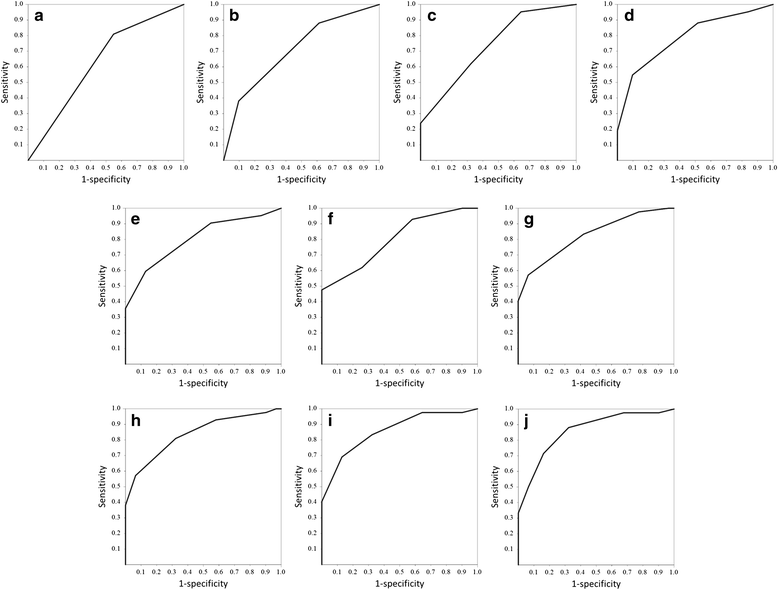An attempt to construct a 7-item short version of the temperament and character inventory to predict the treatment response of patients with depression; a validation study
- PMID: 27520460
- PMCID: PMC4983023
- DOI: 10.1186/s12888-016-0997-0
An attempt to construct a 7-item short version of the temperament and character inventory to predict the treatment response of patients with depression; a validation study
Abstract
Background: The Temperament and Character Inventory (TCI) is a psychological test that is frequently used to assess personality traits. Many studies have shown the potential of the inventory to predict the treatment response of patients with major depressive disorder (MDD). Previously, we showed the association between 10 items of the TCI and the treatment response. In the present study, we reanalyzed the 10 items and aimed to provide cut-off values.
Methods: This work is a secondary analysis of previously published work. Seventy-three patients were enrolled in the previously done study. Participants were treated with 10-40 mg/day of paroxetine for six weeks, and then the participants completed the TCI. The Montgomery-Asberg Depression Rating Scale (MADRS) was used to evaluate depression. The participants were divided into two groups (responders and non-responders). Using chi-squared tests, we reanalyzed the 10 items that had the strongest association with the treatment response in the previous study. We rated the answers to each item associated with the treatment response as a "1", and the answers associated with a non-response were rated as a "0". We calculated predictive scores using 10 models. Each model consisted of 1-10 scores of the best 1-10 items. We defined cut-off values for predicting treatment responses using a receiver operating characteristic (ROC) curve analysis.
Results: Ranked by the strength of the association with the treatment response, items 174, 137, 70, 237, 106, 191, 34, 232, 161, and 215 of the TCI significantly predicted treatment responses. All predictive scores from models 1 to 10 significantly predicted treatment responses. The predictive score threshold of model 7 was 3/4, with an area under the curve of 0.825, and this model showed the highest odds and likelihood ratios (19.3 and 8.86, respectively).
Conclusions: We might predict the treatment response of patients with MDD using TCI predictive scoring, including items 174, 137, 70, 237, 106, 191, and 34 and a cut-off value of 3/4.
Keywords: Antidepressants; Depression; Major depressive disorder; Paroxetine; Predict; Response; Temperament and character inventory.
Figures
Similar articles
-
An investigation of temperament and character inventory items for predicting the response to paroxetine treatment in patients with major depressive disorder.J Affect Disord. 2014 Aug;165:109-13. doi: 10.1016/j.jad.2014.04.076. Epub 2014 May 4. J Affect Disord. 2014. PMID: 24882186
-
Changes in the Temperament and Character Inventory dimensions after paroxetine treatment in patients with major depressive disorder.Hum Psychopharmacol. 2015 Sep;30(5):334-40. doi: 10.1002/hup.2479. Epub 2015 Apr 7. Hum Psychopharmacol. 2015. PMID: 25845342
-
The influence of personality factors on paroxetine response time in patients with major depression.J Affect Disord. 2011 Dec;135(1-3):321-5. doi: 10.1016/j.jad.2011.06.050. Epub 2011 Jul 23. J Affect Disord. 2011. PMID: 21784533 Clinical Trial.
-
Use of the Temperament and Character Inventory to Predict Response to Repetitive Transcranial Magnetic Stimulation for Major Depression.J Psychiatr Pract. 2016 May;22(3):193-202. doi: 10.1097/PRA.0000000000000150. J Psychiatr Pract. 2016. PMID: 27123799 Free PMC article.
-
[Personality factors in depressive disorders: contribution of the psychobiologic model developed by Cloninger].Encephale. 2002 Jul-Aug;28(4):363-73. Encephale. 2002. PMID: 12232546 Review. French.
References
-
- Pawlak J, Dmitrzak-Weglarz M, Skibinska M, Szczepankiewicz A, Leszczynska-Rodziewicz A, Rajewska-Rager A, Maciukiewicz M, Czerski P, Hauser J. Suicide attempts and psychological risk factors in patients with bipolar and unipolar affective disorder. Gen Hosp Psychiatry. 2013;35(3):309–13. doi: 10.1016/j.genhosppsych.2012.11.010. - DOI - PubMed
MeSH terms
Substances
LinkOut - more resources
Full Text Sources
Other Literature Sources


